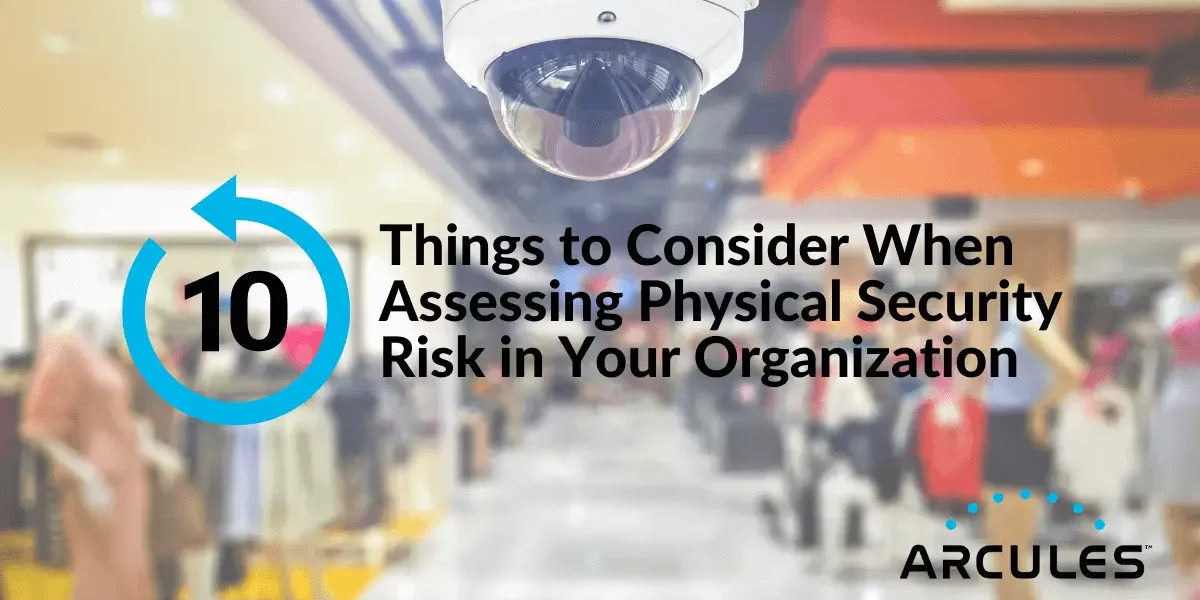As security threats continue to evolve each year, security solutions have risen to challenge them. A vital operation in security, risk assessment, has also taken on a brand new role. Taking the place of reactive and stand alone models, the new standard for risk assessment harnesses proactive and strategic models capable of assessing and detecting risks in real-time.
Here at Arcules, we understand the importance of proper risk assessment and the invaluable role it plays in securing your infrastructure. With that being said, we want to share a few things to consider when assessing risk in your organization.
Recognize Assets First
Before you can begin to determine what the risks are within your organization, you must decide what needs to be protected. Perhaps you unfortunately learned about this the hard way, or have just started a new business. Depending on the type of sector your organization falls into, there are different assets that can often require varying forms of protection.
Identify Risks Early
After the assets have been solidified, you must identify the actual risks that harm or could potentially harm your organization. It’s important to realize that not all risks are the same. For example, perhaps you are in retail and are mostly concerned about theft. Truly take the time to process through the forms of theft that plague your organization and decide how you want your security infrastructure to alleviate this.
Stay Organized
Create categories for your assets and associated risks. Determine the level of risk for each category and prioritize which assets require the most protection. Not only will this proactiveness benefit your organization, but it will allow the security manufacturer or provider to properly assess and equip your organization with the correct technology.
Learn from The Past
If your organization unfortunately suffered from threats in the past, use that data to drive security proactiveness for the future. Remember how and when the damage occurred and use that to fuel your security operations going forward.
Strategize, Strategize, Strategize
Creating a strategic risk assessment plan is one of the best ways to assist your security provider and your organization. This ultimately brings us back to being proactive, and we can’t stress enough how important it is to be strategic about assessing and managing risks in your organization. Don’t be afraid to shift strategy if the situation calls for it. Keep in close contact with your team and security provider regarding your risk assessment plan.
Prioritize Safety
Creating a security plan with your organization, or integrator is one of the best things you can do to keep your assets safe. However, the communication should not stop there. Be in contact with your security provider about what steps your team can take to prioritize safety at your organization, and don’t be afraid to communicate your thoughts on security infrastructure.
Take Responsibility
Securing your infrastructure is of vital importance. Whether that be protecting the lives of your customers, employees, finances, or products, taking responsibility to prioritize safety, create a plan, and coordinate with the proper security provider ultimately falls on the owner’s or appointed leaders shoulders. Take responsibility for your organization’s assets, and set yourself up for success.
Think Positive
Not all risks are bad! There can come a time when your organization is faced with a positive risk, such as an upcoming policy change, or a developing technology. Be in contact with your security provider and keep them updated if you feel it’s appropriate.
Review Often
After a security infrastructure has been deployed, that doesn’t necessarily mean it’s out of sight, out of mind. One benefit of having cloud-based solutions and SAaS is that your organization will be able to focus on it’s primary business functions without added stress or resources being focused on security operations. However, you should still stay in touch with your security provider regarding your security needs to ensure that the plan continues to be successful.
Ask Questions
Finally, don’t be afraid to ask questions! Seeking out knowledge in the industry of physical and cyber security can only benefit your organization. Make sure you have a solid understanding of what security solutions are available to your organization and the best practices for deploying them. If you have a security infrastructure in place, don’t be afraid to bring any concerns or questions to your security provider. They want you to feel comfortable and secure with the operations and help in any way they can.

